Linksys - Re9000 Ac3000 Mu-mimo Wi-fi Range Extender Review
Linksys RE9000 MU-MIMO Range Extender Reviewed

| At a glance | |
| Product | Linksys MU-MIMO Range Extender (RE9000) [Website] |
| Summary | Tri-band Wi-Fi Range Extender based on MediaTek chipset. |
| Pros | • Less expensive than NETGEAR EX8000 with similar performance • Pocket-sized footprint that can be wall/ceiling mounted • Four port Gigabit switch |
| Cons | • Doesn't use ii.4 GHz every bit backhaul |
Introduction
Linksys' RE9000 MU-MIMO Range Extender follows NETGEAR'southward EX8000 Nighthawk X6S Tri-Ring WiFi Range Extender as the second "tri-ring"/three-radio Wi-Fi extender to hit the streets. Linksys has decided to use toll as its chief ways of knocking the EX8000 downwardly a peg or 2 in sales, given its current $170 cost vs. the RE9000's $230. I'll be comparing the two throughout the review.
The RE9000 combines a two-stream dual-band 802.11ac AC1300 class radio with a third, four-stream 5 GHz radio. Maximum link rates of 400 Mbps (ii.4 GHz), 867 Mbps (5 GHz) and 1733 Mbps (5 GHz) add together exactly upwardly to the 3000 Linksys uses equally the RE9000's class rating. And then far, this puts the RE9000 and EX8000 on equal footing.
Both products always prefer to employ the highest-bandwidth iv-stream 5 GHz radio to connect back to the base router being extended, i.e. for backhaul. However, where the EX8000 uses the 5 GHz U-NII-3 high band (Channels 149-165) for its four-stream backhaul radio, the RE9000 uses the U-NII-1 low ring (Channels 36-48). Since maximum immune transmit ability is at present the same for both aqueduct groups, this should take no effect on functioning.

Linksys RE9000 compages
Simply you'll want to make certain yous alter the base router 5 GHz channel to allow the RE9000 to accept full reward of its maximum bandwidth if y'all have a iii or iv-stream router. In the old days before Wi-Fi classification became the mess information technology now is, information technology was much easier to tell how many streams a router used. The simple approach for the RE9000 is, if in doubt, simply set your base of operations router'southward 5 GHz radio to 36, twoscore, 44 or 48.
The more significant difference between the Linksys and NETGEAR, however, is that the RE9000 does non use the 2.4 GHz radio for backhaul. The EX8000 prefers to utilise its four or 2-stream v GHz radios for backhaul, only volition fall back to using ii.4 GHz if it can't connect on 5 GHz. I suspect this is a software limitiation and could exist changed in a future firmware release. Simply when I confirmed the no-ii.4 GHz-for-backhaul "feature" with Linksys, they didn't say they would be changing this limitation.
In any event, the RE9000 is like most other of today'south extenders and doesn't crave your router to support WDS. The RE9000's connexion sorcerer has a congenital-in site survey to brand setup piece of cake.
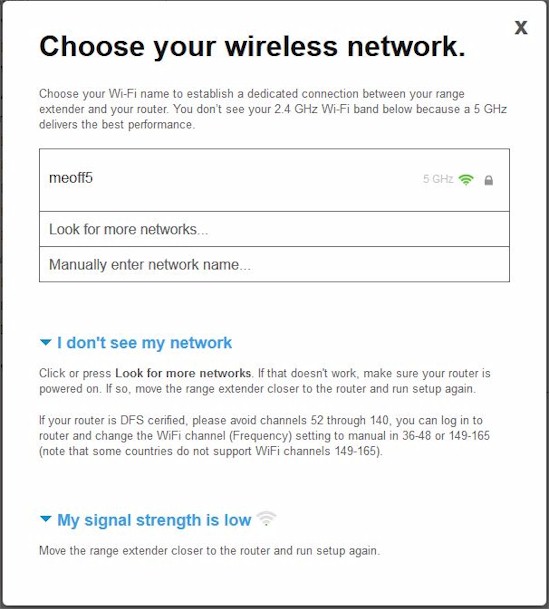
Linksys RE9000 site survey
The RE9000 is a compact little guy and could be mistaken for 1 of Linksys' remaining E1200 or E2500 North-class routers were information technology not for the four external dual-ring antennas (non upgradeable). The LED callouts shows the unmarried LED used to communicate status. I'1000 red/greenish colour blind, so the pick of green and orange colors were not expert for me.
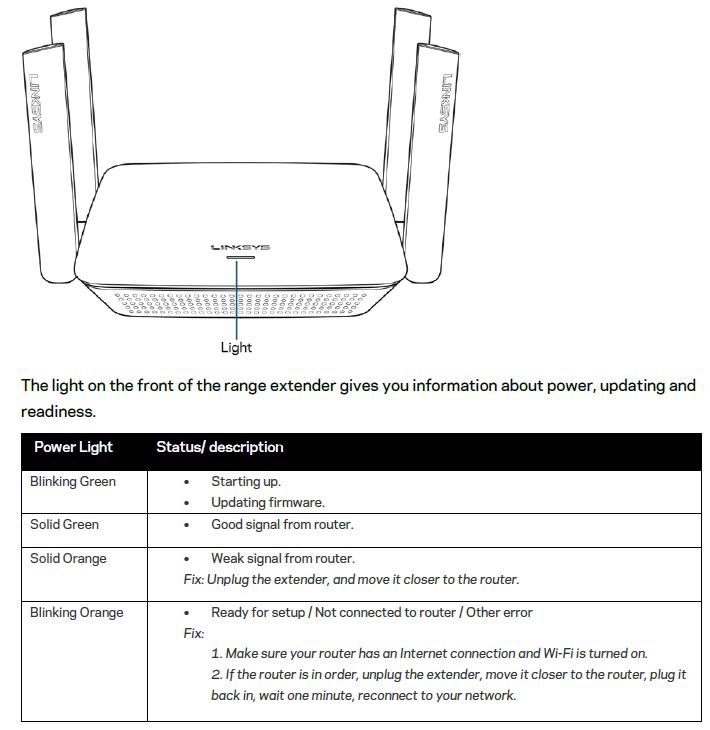
Linksys RE9000 LED callouts
The rear panel callouts show the four Gigabit Ethernet ports, power port and reset button. There's also a WPS push on the right side. Each Ethernet port has a link/activity LED. One of the things you don't get with the RE9000's lower price is the ability to serve/share files from USB storage.
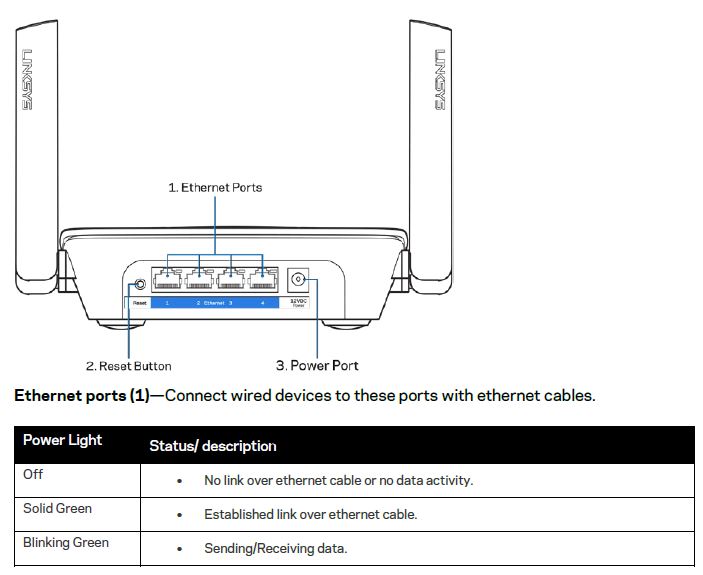
Linksys RE9000 rear callouts
The RE9000 can sit down on a shelf or table but as well has screw mounting slots on its bottom that let pointing the rear connectors up or down.
Within
The RE9000'south short term confidentiality period expired, so I was able to employ the FCC internal photos. It's a niggling difficult to see in the photo below, merely the two black cables connect the 2x2 ii.four/v GHz radio to the rear two antennas. The four gray cables connect the 4x4 five GHz radio to all four antenna positions.
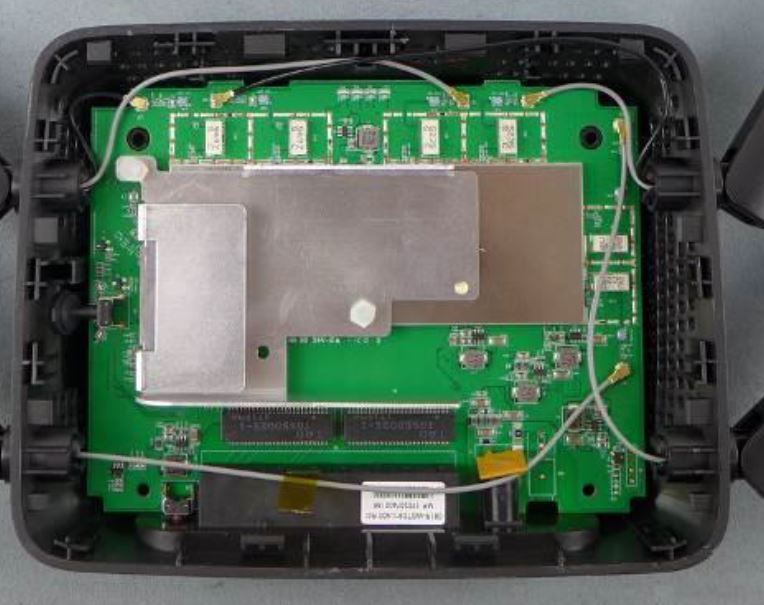
Linksys RE9000 inside
Some other FCC photo makes the RE9000's MediaTek platform pretty obviously. Not chosen out here, merely shown in a close-up photograph is the MediaTek MT7621AT dual-core network processor powering the whole shebang. The white v GHz ring filters are labeled with frequency values that make it easy to tell which radios are which.
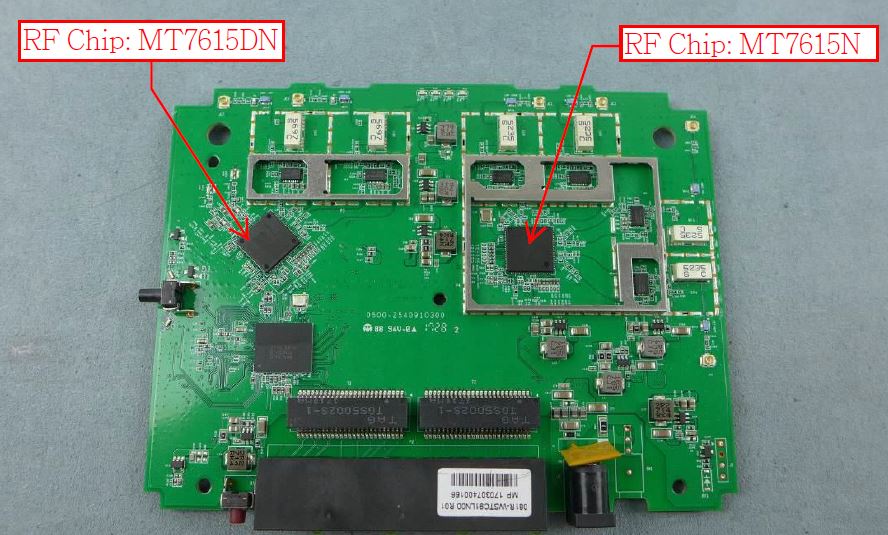
Linksys RE9000 board top
The table shows the key components of the RE9000 and NETGEAR EX8000 for comparison. The FCC photos didn't clearly evidence the RE9000'due south RAM and flash, and then I used WikiDevi's gauge. I could find no sign of any two.4 GHz power amplifiers or front ends, by the fashion.
| Linksys RE9000 | NETGEAR RE9000 | |
|---|---|---|
| CPU | MT7621AT Dual-core Network Processor | Qualcomm IPQ4019 |
| Switch | In MT7621AT | QCA8075 |
| RAM | 128 MB (?) | 512 MB |
| Wink | 16 MB (?) | 32 MB |
| ii.4 GHz Radio (2x2) | - Mediatek MT7615DN - No ability amp | - In IPQ4019 - Skyworks SKY2623L 2.4 GHz Power Amp (x2) |
| 5 GHz radio (2x2) | - Mediatek MT7615DN - SKY85728-xi 5 GHz WLAN Front end-End Module (x2) | - In IPQ4019 - RFMD RFPA5542 5 GHz power amp (x2) |
| 5 GHz backhaul (4x4) | - MediaTek MT7615N - SKY85728-11 5 GHz WLAN Forepart-Stop Module (x4) | - QCA9984 - RFMD RFPA5542 5 GHz power amp (x4) |
Table i: Linksys RE9000 central components
Source: http://www.smallnetbuilder.com/wireless/wireless-reviews/33168-linksys-re9000-mu-mimo-range-extender-reviewed
0 Response to "Linksys - Re9000 Ac3000 Mu-mimo Wi-fi Range Extender Review"
Post a Comment